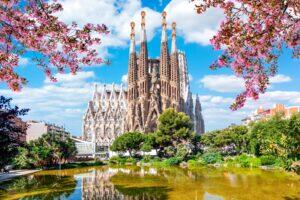Fodor's Expert Review Casa Calvet
This exquisite but more conventional town house (for Gaudí, anyway) was the architect's first commission in the Eixample (the second was the dragon-like Casa Batlló, and the third, and last—he was never asked to do another—was the stone quarry–esque Casa Milà). Peaked with baroque scroll gables over the unadorned (no ceramics, no color, no sculpted ripples) Montjuïc sandstone facade, Casa Calvet compensates for its structural conservatism with its Moderniste details, from the door handles to the benches, chairs, vestibule, and spectacular glass-and-wood elevator. Built between 1898 and 1900 for the textile baron Pere Calvet, the house includes symbolic elements on the facade, ranging from the owner's stylized letter "C" over the door to the cypress, symbol of hospitality, above. The wild mushrooms on the main (second) floor reflect Pere Calvet's (and perhaps Gaudí's) passion for mycology, while the busts at the top of the facade represent St. Peter, the owner's patron saint,... READ MORE
This exquisite but more conventional town house (for Gaudí, anyway) was the architect's first commission in the Eixample (the second was the dragon-like Casa Batlló, and the third, and last—he was never asked to do another—was the stone quarry–esque Casa Milà). Peaked with baroque scroll gables over the unadorned (no ceramics, no color, no sculpted ripples) Montjuïc sandstone facade, Casa Calvet compensates for its structural conservatism with its Moderniste details, from the door handles to the benches, chairs, vestibule, and spectacular glass-and-wood elevator. Built between 1898 and 1900 for the textile baron Pere Calvet, the house includes symbolic elements on the facade, ranging from the owner's stylized letter "C" over the door to the cypress, symbol of hospitality, above. The wild mushrooms on the main (second) floor reflect Pere Calvet's (and perhaps Gaudí's) passion for mycology, while the busts at the top of the facade represent St. Peter, the owner's patron saint, and St. Genis of Arles and St. Genis of Rome, patron saints of Vilassar, the Calvet family's hometown in the coastal Maresme north of Barcelona. Note that the only part of the building accessible to visitors is the ground-floor China Crown restaurant, originally the suite of offices for Calvet's textile company, with its exuberant Moderniste decor.
READ LESS








